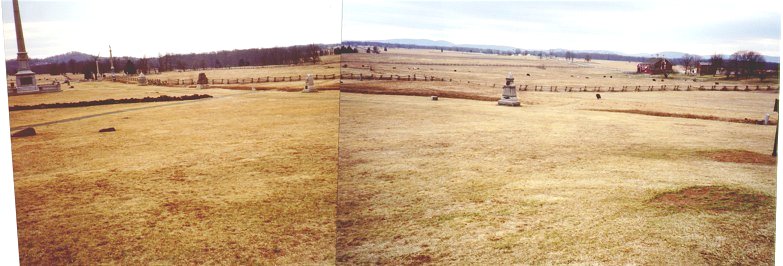
Pickett's Charge Part 3

Hancock Wounded
Hancock had been observing the battle from this area in front of the Union line. To his right, the Confederates were advancing toward the Copse of Trees. The vulnerability of their flank was obvious, so Hancock ordered Stannard to take his New Vermont Brigade, deployed in the general area from here to the right, forward to flank the Confederate attack. Near the climax of the battle, Hancock was wounded in the groin but remained on the field during the action. The wound would cause him much discomfort for the rest of his life.

Side View of the So-Called "High Water Mark of the Confederacy"
This is the view looking south into the most famous area of the battlefield. The car on the left is on the road shown in the "Union Line Vs. Pettigrew and Trimble" photo. As we have seen north of here, the main Union line was along this modern day road. A supporting line continued along this line, but where the stone wall shown here intersects, the Union front line abruptly shifted forward to "The Angle" at the right of the picture near the solitary tree. Along this forward line the Union troops would have a better field of fire.
With his hat on his sword, Armistead pushed forward with his men. As he put his hand toward the barrel of one of the artillery pieces, he was mortally wounded. (Although the guns visible here in front of the Copse of Trees represents these guns, they are actually thought to have been much further forward.) His men couldn't break the 72nd and 106 Pa. on the main line. These two regiments suffered 47% casualties, but they held. Federal units rushed to contain the penetration.

Stannard's Flank Attack
As you can see, the Confederates in this area couldn't see Pettigrew's and Trimble's men to their left. They wrongly believed that they were unsupported on their left.
Stannard of the New Vermont Brigade was posted to the left of Copse of Trees in the Union line. No sizable Confederate troops faced Stannard, so Hancock ordered him to move his brigade forward and face right to enfilade the advancing Rebels. This is the approximate view his men had as they poured flanking fire on the attacking Confederates.
The lone tree in the center of the picture is the Angle near where Armistead penetrated the line held by the 71st Pa. Further to the right is the Copse of Trees which was held by parts of Harrow's and Hall's brigades as they held off Armistead. In front of the Copse of trees and down from the Angle, the stone wall was defended by the 69th Pa., which sustained 50% losses as they held off Kemper's brigade. A few Confederates rushed over the wall but were killed or wounded by double-shotted canister from the guns visible near the tower.
Stannard's brigade enfiladed Kemper's men, preventing them from expanding Armistead's penetration. Armistead's men had lost their leader, their comrades on the left and right had been forced back, and they were now facing Union reinforcements. They joined their comrades in the long retreat back to Seminary Ridge.

Stannard Faces South
This is the view from behind the Union line, and you can see the shallow entrenchments which had been dug along the line. In advance of the main line, part of Stannard's brigade now turned to the south and flanked and repulsed Perry's and Wilcox's brigades as they belatedly advanced on the far side of the Codori Farm - visible on the right. This completed the epic attack.
Near the Virginia Monument, Lee had witnessed the attack. Now he met his returning men and blamed himself for the failure. Of the approximately 12,000 men who assaulted Cemetery Ridge, 7,000 were killed, wounded, or captured. Whether the attack could have succeeded is subject to debate. Perhaps a supporting line would have carried the position, but could the Confederates have overcome Union reserves? Who knows?
Over three days of fighting at Gettysburg, Lee's 75,000 man army had lost 28,000 killed, wounded, and missing. Lee's army remained on the field on July 4th awaiting an attack that never came. The next day, they began the withdrawal to Virginia.